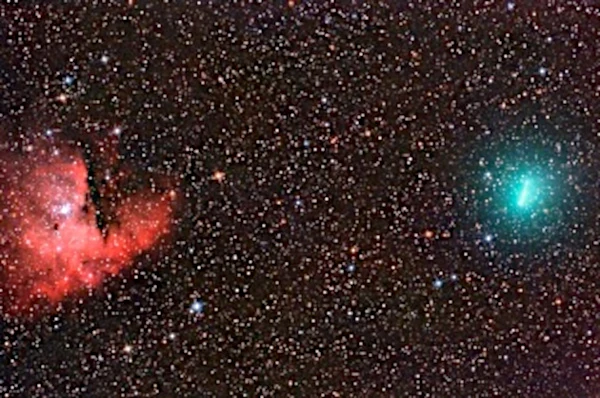
On November 4, 2010, the Deep Impact probe, reassigned to the EPOXI mission, flew by comet 103P/Hartley 2 at just 700 km. This small celestial body, about 2.2 km long and 0.4 km wide, offered an unexpected spectacle: a dumbbell-shaped nucleus, from which jets of gas and dust escape. Hartley 2, although modest in size, reveals surprisingly intense activity.
High-resolution images show a nucleus with two dense lobes connected by a narrower, less massive central region. This configuration suggests a bilobed structure, potentially formed by the gentle accretion of two distinct objects. The comet contains a high proportion of CO\(_2\) ice, volatile at low temperatures, which explains persistent activity even far from the Sun.
Unlike typical comets that release water as they approach the Sun, Hartley 2 massively releases CO\(_2\) from its ends. These jets are capable of projecting centimeter-sized aggregates of water ice at high speed. This behavior reveals a deep outgassing mechanism, where solar heat reactivates internal pockets of CO\(_2\) ice, stimulating sublimation and erosion processes.
The EPOXI mission combined two objectives: the study of exoplanets (Epoxi) and the exploration of comets (DIXI). Hartley 2 was thus the fifth comet to be closely flown by a space probe, after Halley, Borrelly, Wild 2, and Tempel 1. The detailed analysis of its surface and dynamics allows for a better understanding of the first materials of the Solar System, preserved in the cometary nucleus.
The isotopic composition of Hartley 2's water, measured indirectly, is compatible with that of Earth's oceans (\(D/H \sim 1.61 \times 10^{-4}\)), which supports the hypothesis that Jupiter Family Comets (JFC) may have played a major role in delivering water to Earth.
| Parameter | Value | Unit | Remarks |
|---|---|---|---|
| Official Name | 103P/Hartley | – | Periodic comet of the Jupiter family |
| Orbital Period | 6.47 | years | Strongly influenced by Jupiter |
| Nucleus Dimensions | 2.2 × 0.4 | km | Elongated bilobed shape |
| Perihelion Distance | 1.05 | AU | Just beyond Earth's orbit |
| Volatile Composition | CO\(_2\), H\(_2\)O | – | Jets rich in CO\(_2\) |
| Flyby Date | November 4, 2010 | – | 700 km from the nucleus |
Source: NASA – Solar System Exploration and Journal ApJ, 2011.